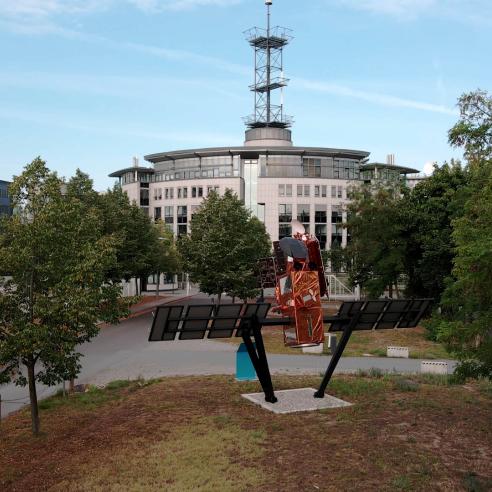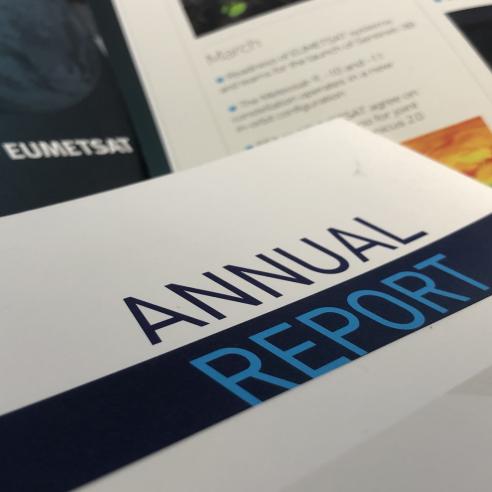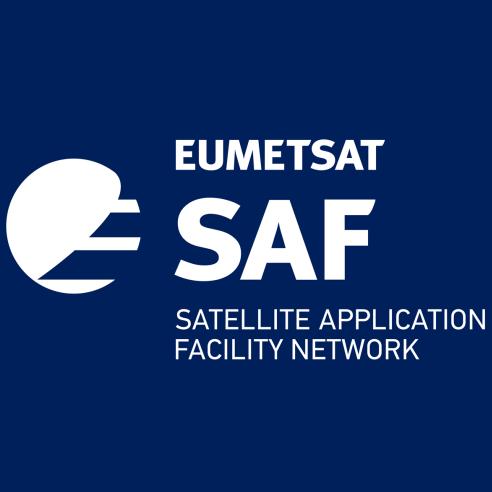What we do
EUMETSAT is the European operational satellite agency for monitoring weather, climate and the environment.
We operate a system of meteorological satellites that observe the atmosphere and ocean and land surfaces – 24 hours a day, 365 days a year.
11 March 2025
18 May 2020
Global risk reports repeatedly warn against climate change and its consequences as being the major possible cause of disruption in the coming years and decades. The 2022-2023 World Economic Forum Global Risks Perception Survey lists two risks related to climate change as the most likely to cause disruptions in the next 2 and 10 years.
Reliable weather forecasts are key to our safety and our economies. To help save lives and reduce damage to property and infrastructure from storms, heavy precipitation, heat waves and tropical cyclones – as well as other hazards influenced by weather, such as floods or dispersion of atmospheric or marine pollution – European citizens and decision-makers require timely warnings from their National Meteorological Services, which are based on reliable weather forecasts.
Between 1980 and 2021, weather- and climate-related extremes caused economic losses estimated at EUR 560 billion in the EU Member States, according to the European Environment Agency. Statistical analysis also shows that these economic losses increase over time. The importance of accurate and timely weather forecasts increases in parallel to support business continuity and protect economies. This is particularly true for the energy, transportation, construction, agriculture, tourism and utility sectors. Energy providers, for example, rely on weather forecasts to anticipate power demand and adapt their production during both hot and cold spells. With the development of renewable energy, production itself will increasingly depend on the weather. Likewise, forecasts of fog, snow, high winds, thunderstorms and weather-induced dispersion of ash particles are critical to aviation and air-traffic management, and by extension to the global economy.
Accurate weather predictions start from the best possible knowledge of the initial state of the Earth's atmosphere, which is modelled using frequent, global observations of the atmosphere, the oceans and the underlying surfaces. At the end of 2020, according to studies from the Met Office, 24-hour global forecast were 78% more precise thanks to satellite data (with data from the Metop satellites accounting for 25 percent of this increase). Earth observation from space has become indispensable for forecasting the weather at all ranges, contributing to the downstream production of warnings and other information that support our continued social and economic wellbeing.
Severity of risk over the next 2 years
- Cost of living crisis
- Natural disasters and extreme weather events
- Geoeconomic confrontation
- Failure to mitigate climate change
- Erosion of social cohesion and societal polarization
- Large-scale environmental damage incidents
- Failure of climate-change adaptation
- Widespread cybercrime and cyber insecurity
- Natural resource crises
- Large-scale involuntary migration
Severity of risk over the next 10 years
- Failure to mitigate climate change
- Failure of climate-change adaptation
- Natural disasters and extreme weather events
- Biodiversity loss and ecosystem collapse
- Large-scale involuntary migration
- Natural resource crises
- Erosion of social cohesion and societal polarization
- Widespread cybercrime and cyber insecurity
- Geoeconomic confrontation
- Large-scale environmental damage incidents
Risk categories
- ● Environmental
- ● Geopolitical
- ● Societal
- ● Technological
Source: World Economic Forum Global Risks Perception Survey 2022-2023.
From satellite development to data distribution
EUMETSAT’s mission is to establish, maintain and exploit European systems of meteorological satellites.
Establishing the systems
EUMETSAT is committed to delivering Earth observation satellite data 24/7, as well as to meeting the needs of the national weather services of its member states. We plan and develop the future satellite systems required to ensure the continuity of our vital service and the constant adaptation to evolving forecasting and climate monitoring needs. Such systems encompass the spacecraft as well as the ground segment that enable the acquired data to be received, processed ,distributed, stored and later on re-processed to develop climate datasets. The development of the satellites is carried out in cooperation with the European Space Agency (ESA).
The next-generation of European meteorological satellites that will ensure the continuity of our Earth observation data sets until 2040 are being launched between 2022 and 2030 and will be deployed in both Low Earth and Geostationary orbits. Each family of spacecraft is complemented by a dedicated technical infrastructure on Earth.
Meteosat-Third Generation, the geostationary component of the European system, represents the future of nowcasting and very short-range forecasting of high impact weather in Europe and Africa. MTG-Imager 1, the first in the family to be launched, reached its geostationary orbit at the end of 2022.
EUMETSAT Polar System-Second Generation, the polar component of the European system, will enhance the critical inputs delivered to numerical weather prediction models and support operational weather forecasting several days in advance. It will launch in the second half of the 2020s.
EUMETSAT also plays a central role in the operations of the Sentinel satellites from the European Commission’s Copernicus programme observing the atmosphere and the oceans.
Maintaining the systems
EUMETSAT operates satellites in geostationary and polar-orbiting orbits, as well as the ground segments necessary to manage their safe operations and data management.
In geostationary orbit 36,000 km above the equator, our Meteosat satellites orbit the Earth at the same speed as the Earth rotates, thus observing systematically the same footprint of the Earth (the so-called Earth disc) under the same geometry.
The Meteosat-10, -11 and -12 satellites are in geostationary orbit over Europe and Africa, while Meteosat-9, operates over the Indian Ocean. Meteosat-10 is the prime operational geostationary satellite, positioned at 0 degrees and providing full disc imagery every 15 minutes. Meteosat-11 provides the Rapid Scanning Service, delivering more frequent images every five minutes over parts of Europe, Africa and adjacent seas. In the future, the Meteosat-Third Generation system will send images of the full Earth disc every 10 minutes, and every 2,5 minutes for the Rapid Scanning Service over Europe alone.
The constant delivery of frequent, high-quality images of the atmosphere captured and provided in near real-time by the Meteosat satellites is crucial for nowcasting, the real-time detection of rapidly developing weather situations, resulting in high-impact weather events.
The polar-orbiting Metop satellites fly in a low Earth orbit, at an altitude of 817 kilometres. They rotate around the Earth 14 times per day, on an orbit that passes via the poles. Their many instruments provide more detailed observations of the global atmosphere, oceans and continents than Meteosat satellites and their observations are crucial in building accurate numerical weather prediction models.
Studies from 2011 confirm that Metop satellites make a major contribution to the performance of Numerical Weather Prediction (NWP), accounting for 25% of the reduction in 24 hour forecast errors made by ingesting all observations into models in real time.
The ECMWF has increased the number of satellite instruments used as sources of data integrated into its global numerical weather prediction model from 12 to 70 over the past years. The EUMETSAT Metop satellite system alone, with 3 satellites in orbit, accounts for 25 percent of the total network, and is by far the dominant observing system assimilated by the ECMWF. Source: Destination 2030
The ground segments constitute the ground-based infrastructure necessary to support the operations of our satellites, including the control of our spacecraft in orbit, and the acquisition, reception, processing, storing and delivery of their data. The EUMETSAT Mission Control Centre (MCC) is based at our headquarters in Darmstadt, Germany, and is responsible for the safe operations of all satellites.
Comprised of two main control rooms, one for geostationary missions and the other for low Earth orbit missions, it provides the necessary monitoring and control of all operational satellites and the associated ground infrastructure. It also ensures the continuous communication with – and data acquisition from – the spacecraft through a network of primary and backup ground stations distributed across Europe. Teams of satellite and ground segment controllers work around the clock, supported by on-call operators and maintenance engineers.
Exploiting the systems
EUMETSAT delivers satellite data and products in near real-time to data users worldwide.
The data from EUMETSAT’s satellites are processed on the ground to extract a wealth of meteorological, environmental and climate products, the number of which are steadily increasing as a result of scientific innovation. Data and products are then distributed in near real-time to users in Europe, Africa and worldwide, primarily via EUMETCast, our internet- and satellite-based broadcast service for environmental data. EUMETSAT also makes data available online through our User Portal.
Monitoring the climate
Climate services are essential for meeting the challenge of mitigating and adapting to climate change.
A better understanding of climate change and its impact is necessary for governments and decision- makers to define and implement appropriate mitigation and adaptation policies, including investment policies for large infrastructure projects with long lifecycles.
This requires the development of science-based climate services, in synergy with the national weather services in our member states and with the Copernicus Climate Change Service, within the framework established by the WMO. Climate services are based on a combination of input including long series of well calibrated observations, numerical models capable of delivering climate prediction at seasonal to decadal scales, projections at longer scales (in response to emission scenarios), as well as socio-economic data.
EUMETSAT maintains several long-term datasets providing scientists with as much as 40 years’ worth of calibrated and validated data. We are also involved in providing the necessary data to calculate the Essential Climate Variables (ECV); the definition and requirements necessary for the ECVs are established and maintained by the Global Climate Observing System (GCOS) programme.
Find out more on monitoring the climate.


Monitoring the oceans
The oceans play a leading role in shaping the Earth’s climate. They cover 70% of the planet’s surface and have the capacity to store solar radiation and distribute heat and moisture around the globe, thus driving weather systems. Because the global ocean is even more difficult to observe in situ than the atmosphere, the development of operational oceanography relies on ocean-observing satellites.
These satellites are unique sources of continuous, highly accurate global measurements of the physical and biological state of the ocean (sea state, sea level, ocean currents, sea surface temperature, ocean colour and sea ice) and of the atmospheric parameters (ocean surface wind, air-sea fluxes, precipitation) that drive the ocean circulation.
Such observations have far-reaching applications, including safety, shipping, fisheries, management of marine resources, coastal ecosystems and marine pollution and off-shore industry. A recent European study estimated that if all economic activities that depend on the sea are counted, then the European Union's 'blue' economy represents 5.4 million jobs and a gross added value of just under €500 billion per year.
Find out more on our monitoring the oceans page.

Monitoring the atmosphere
The Earth’s atmosphere provides a layer of protection from solar radiations, as well as insulation that keeps the planet warm and enables the water cycle as we know it. Satellite’s data providing global data about atmospheric composition and its physical characteristics are critical for our understanding of weather and climate patterns, as well as to ensure the accuracy of numerical weather prediction models.
Data observed by EUMETSAT’s satellites is also critical to the monitoring and forecasting of air quality, both critical for the health of European citizens, and for our understanding of some of the roots of climate change. Over the last few decades, research by the World Health Organization has established that air pollution is responsible for a broad range of adverse health effects. This evidence, together with environmental protection policies, has stimulated the development of air quality monitoring and forecast services in Europe.
Like weather forecasts, air quality forecasts are based on specialised Numerical Weather Prediction (NWP) models ingesting observations of trace gases and particles, whilst also taking into account natural and man-made emissions. Such models are exploited in combination with NWP models by some National Meteorological Services or other national entities and, at European Union level, by the Copernicus Atmosphere Monitoring Service which delivers air quality forecasts for a few days in advance.
EUMETSAT supports the operational monitoring and forecasting of atmospheric composition through specific observational products from both its geostationary and polar-orbiting satellites.
Find out more on our monitoring the atmosphere page.





